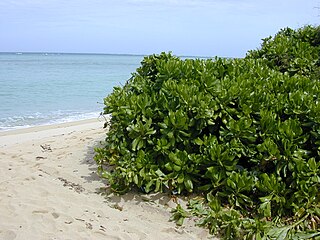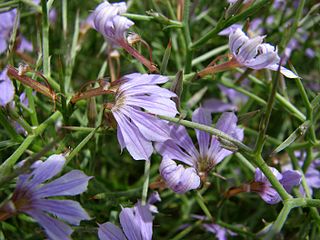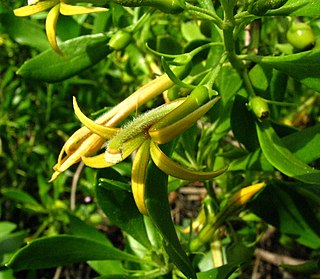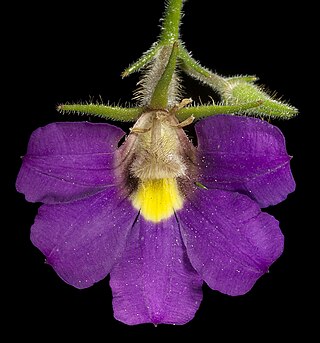
Scaevola is a genus of flowering plants in the Goodenia family, Goodeniaceae. It consists of more than 130 species, with the center of diversity being Australia and Polynesia. There are around 80 species in Australia, occurring throughout the continent, in a variety of habitats. Diversity is highest in the South West, where around 40 species are endemic.

Kaʻena or Kaena Point is the westernmost tip of the island of Oʻahu. In Hawaiian, kaʻena means "the heat". The area was named after a brother or cousin of Pele. The point is designated as a Natural Area Reserve.

Pandanus tectorius is a species of Pandanus (screwpine) that is native to Malesia, Papuasia, eastern Australia, and the Pacific Islands. It grows in the coastal lowlands typically near the edge of the ocean. Common names in English include thatch screwpine, Tahitian screwpine, hala tree and pandanus. The fruit is edible and sometimes known as hala fruit.

Hibiscus waimeae is a species of flowering plant within the okra family, Malvaceae, that is endemic to the island of Kauaʻi in Hawaii.

Sesbania tomentosa, commonly known as Oahu riverhemp and ʻōhai, is an endangered species of plant in the pea family, Fabaceae, that is endemic to the main Hawaiian Islands as well as Nihoa and Necker Island. It inhabits low shrublands and, rarely, dry forests, at elevations from sea level to 2,500 ft (760 m). Associated native plant species include akiʻaki, ilima, naupaka kahakai, and pili. Off-road vehicles, wildfires, grazing, and alien species competition have destroyed their habitat on the main islands, but they are still quite common on Nihoa and Necker. At least 2000 specimens grow on Nihoa, while there are far less on Necker.

Sida fallax, known as yellow ilima or golden mallow, is a species of herbaceous flowering plant in the Hibiscus family, Malvaceae, indigenous to the Hawaiian Archipelago and other Pacific Islands. Plants may be erect or prostrate and are found in drier areas in sandy soils, often near the ocean. ʻIlima is the symbol of Laloimehani and is the flower for the islands of Oʻahu, Hawaiʻi, and Abemama, Kiribati.

Brighamia rockii, known as the Molokai ohaha or Pua ʻala in Hawaiian, is a species of flowering plant in the bellflower family, Campanulaceae, that is endemic to the island of Molokaʻi in Hawaii. Pua ʻala inhabits mesic shrublands and forests on rocky cliffs from sea level to 470 m (1,540 ft) on the island's northern windward coast. Associated plants include ʻōhiʻa lehua, alaheʻe, lama, ʻūlei, and naupaka.

Scaevola coriacea, the dwarf naupaka, is one of the ten Scaevolas, that are endemic to Hawaii.

Scaevola glabra, the 'ohe naupaka, is a shrub in the family Goodeniaceae. The flowers are yellow.

Cyanea is a genus of flowering plants in the family Campanulaceae that are endemic to Hawaii. The name Cyanea in Hawaiian is hāhā.

Isodendrion laurifolium is a rare species of flowering plant in the violet family known by the common names rockcliff isodendrion and aupaka. It is endemic to Hawaii, where it is known from fewer than 1000 individuals on the islands of Kauai and Oahu. It is a federally listed endangered species of the United States.

Plantago princeps is a rare species of flowering plant in the plantain family known by the common name ale. It is endemic to Hawaii, where it is known from the islands of Hawaii, Kauai, Oahu, Molokai, and Maui. Like other Hawaiian Plantago, it is known as kuahiwi laukahi, or laukahi kuahiwi. It is a federally listed endangered species of the United States.

Viola chamissoniana is a species of flowering plant in the violet family known by the common name 'olopu. It is endemic to Hawaii, where it is known from the islands of Kauai, Oahu, Molokai, and Maui.

Scaevola taccada, also known as beach cabbage, sea lettuce, or beach naupaka, is a flowering plant in the family Goodeniaceae found in mangrove swamps and rocky or sandy coastal locations in the tropical areas of the Indo-Pacific. It is a common beach shrub throughout the Arabian Sea, the tropical Indian Ocean and the tropical islands of the Pacific Ocean.

Scaevola platyphylla, commonly known as broad-leaved fanflower, is a shrub in the family Goodeniaceae. It is endemic to the south-west of Western Australia. Plants grow to between 0.3 and 1.3 metres high and have blue to purple flowers that appear between August and January in their native range.

Scaevola oxyclona, commonly known as tangled fanflower, is a spiny shrub in the family Goodeniaceae, native to Western Australia. It grows to between 0.1 and 1.5 metres high and produces blue to purple flowers from August to December in its native range. The species was first formally described in 1876 by Victorian Government Botanist Ferdinand von Mueller in the tenth volume of Fragmenta Phytographiae Australiae based on plant material collected at Frasers Range and Mount Benjamin.

Scaevola gaudichaudii, the ridgetop naupaka, is a shrub in the family Goodeniaceae. The flowers are yellow. The plant is endemic to Hawaii.

Scaevola gaudichaudiana, the mountain naupaka, is a perennial shrub in the family Goodeniaceae. The plant is endemic to Hawaii.

Scaevola phlebopetala, commonly known as velvet fanflower, is a herb in the family Goodeniaceae and is endemic to Western Australia.

Scaevola kilaueae, the Kīlauea naupaka, is a species of fanflower endemic to the eastern windward side of the island of Hawaiʻi.




















